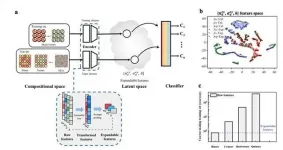What brings olfactory receptors to the cell surface
"Zip codes" for odor sensors identified
2021-03-17
(Press-News.org) A team of scientists led by Dietmar Krautwurst from the Leibniz Institute for Food Systems Biology at the Technical University of Munich has now identified address codes in odorant receptor proteins for the first time. Similar to zip codes, the codes ensure that the sensor proteins are targeted from inside the cell to the cell surface, where they begin their work as odorant detectors. The new findings could contribute to the development of novel test systems with which the odorant profiles of foods can be analyzed in a high-throughput process and thus could be better controlled.
The genes of the approximately 400 human odorant receptor types have been identified for about 20 years. Nevertheless, for about 80 percent of these sensor proteins, it is still not known to which odorants they respond. Knowing this, however, is an important prerequisite for developing bio-based "artificial noses" for food controls.
Cellular test systems
But how can this problem be solved? Normally, scientists use cellular test systems to find out to which substances a receptor protein reacts. However, a particular problem with odorant receptors is that they often are stuck inside the test cells, and hardly reach the cell surface. Even for a suitable odorant it is then difficult to dock onto enough receptors to activate a cellular function. Thus, odorant assignment to individual receptor types is hampered.
However, why do odorant receptors so often become stuck in test cells, and what molecular mechanisms are involved in the transport of odorant receptors to the cell surface? To help answer these fundamental questions, the team of scientists examined and compared the protein sequences of 4,808 odorant receptors from eight different species using statistical and phylogenetic analysis methods. This enabled the team to identify highly conserved amino acid motifs. These are localized in the respective C-terminal end of the receptor proteins, which protrudes into the cell interior (cytoplasm).
Address codes identified
"The structure-function analyses we performed indicate that certain amino acid motifs and their combinations in different receptor types individually promote their cell surface expression and signaling. They function like address codes, or 'zip codes'," reports Dietmar Krautwurst, who led the study. "Such amino acid motifs were previously unknown for olfactory receptors," the biologist continued. "We assume that the odorant receptor molecules interact with cellular proteins via these motifs, which guide the sensor proteins to their site of action on the cell surface via mechanisms that are still unknown."
The researchers led by Dietmar Krautwurst hope that their new findings will help to optimize cellular assay systems for odorant receptors in such a way that it will soon be possible to determine the corresponding odorant partners for each odorant receptor. The team of scientists agrees that only if the recognition spectra of as many odor receptors as possible are known, it will be possible to develop receptor-based test systems by which the odor quality of foods can be reliably and rapidly monitored online during production.
INFORMATION:
Publication: Kotthoff M, Bauer J, Haag F, Krautwurst D (2021) FASEB J, 35: e21274. DOI: 10.1096/fj.202000182RR. Conserved C-terminal motifs in odorant receptors instruct their cell surface expression and cAMP signaling.
http://dx.doi.org/10.1096/fj.202000182RR
Background information:
We perceive the odor of food through odorant receptors. They are located on the surface of nerve cell endings embedded in the nasal mucosa. Each nerve cell expresses only one of the approximately 400 types of olfactory receptors active in humans.
To date, scientists have identified a total of about 10,000 different volatile aroma compounds in foods. Of these, however, only about 230, so-called key odorants, are decisive for the overall olfactory impression. About 3 to 40 of these compounds are necessary and sufficient to shape the typical scent of a food or beverage. Combined in the right proportions, they activate the olfactory receptors in our nose in a specific way. This creates neuronal signal patterns that merge in the brain to form the characteristic scent of a food.
Source: Nature's chemical signatures in human olfaction: a foodborne perspective for future biotechnology. Dunkel A, Steinhaus M, Kotthoff M, Nowak B, Krautwurst D, Schieberle P, Hofmann T. Angew Chem Int Ed Engl. 2014 Jul 7;53(28):7124-43. DOI: 10.1002/anie.201309508.
https://onlinelibrary.wiley.com/doi/full/10.1002/anie.201309508
How do receptor reporter assays in test cell systems work? ? Simply explained
In such systems, researchers use cells that grow in a Petri dish containing culture medium. Typically, the cells are genetically modified to produce the type of receptor under investigation. They integrate receptors into their cell membrane, and present them on the cell surface in a manner similar to an antenna. To test whether a particular receptor type reacts to a certain substance, the researchers add the substance to the nutrient medium. If the receptor recognizes the substance as an adequate stimulus, the cells will then respond with an appropriate activation signal, which can be measured and quantified.
Contact:
PD Dr. Dietmar Krautwurst
Leibniz Institute for Food Systems Biology at the Technical University of Munich
Lise-Meitner-Str. 34, 85354 Freising
Email: d.krautwurst.leibniz-lsb@tum.de
Press Contact:
Dr. Gisela Olias
Leibniz Institute for Food Systems Biology at the Technical University of Munich
Lise-Meitner-Str. 34, 85354 Freising
Knowledge transfer, Press & Public Relations
Phone: +49 8161 71-2980
Email: g.olias.leibniz-lsb@tum.de
http://www.leibniz-lsb.de
Information about the Leibniz Institute
The Leibniz Institute for Food Systems Biology at the Technical University of Munich (Leibniz-LSB@TUM) has a unique research profile. Its researchers combine methods of basic biomolecular research with analytical methods of bioinformatics and analytical high-performance technologies. Their goal is to decode the complex ingredient profiles from raw materials to the final food products and to elucidate their function as biological active molecules on humans. Based on their studies, the scientists develop products, which are as healthy as they are tasty. These foods will help to provide a sustainable and sufficient stream of food for future generations. In addition, the new scientific findings will be used to develop personalized nutritional concepts that, for example, help people with food intolerance without compromising quality of life and endangering their health.
The Leibniz LSB@TUM is a member of the Leibniz Association, which connects 96 independent research institutions. Their orientation ranges from the natural sciences, engineering and environmental sciences through economics, spatial and social sciences to the humanities. Leibniz Institutes devote themselves to social, economic and ecological issues. They conduct knowledge-oriented and application-oriented research, also in the overlapping Leibniz research networks, are or maintain scientific infrastructures and offer research-based services. The Leibniz Association focuses on knowledge transfer, especially with the Leibniz Research Museums. It advises and informs politics, science, business and the public. Leibniz institutions maintain close cooperation with universities - among others, in the form of the Leibniz Science Campuses, industry and other partners in Germany and abroad. They are subject to a transparent and independent review process. Due to their national significance, the federal government and the federal states jointly fund the institutes of the Leibniz Association. The Leibniz Institutes employ around 20,000 people, including 10,000 scientists. The entire budget of all the institutes is more than 1.9 billion euros.
+++ Via our Twitter channel https://twitter.com/LeibnizLSB you stay up to date +++
[Attachments] See images for this press release:

ELSE PRESS RELEASES FROM THIS DATE:
2021-03-17
Alchemy, which attempted to turn cheap metals such as lead and copper into gold, has not yet succeeded. However, with the development of alloys in which two or three auxiliary elements are mixed with the best elements of the times, modern alchemy can produce high-tech metal materials with high strength, such as high entropy alloys. Now, together with artificial intelligence, the era of predicting the crystal structure of high-tech materials has arrived without requiring repetitive experiments.
A joint research team of Professor Ji Hoon Shim and Dr. Taewon Jin (first author, currently at KAIST) of POSTECH's Department of Chemistry, and Professor Jaesik Park of POSTECH Graduate School of Artificial Intelligence have together developed a system that predicts ...
2021-03-17
TROY, N.Y. -- Numeric anchoring is a long-established technique of marketing communication. Once a price is mentioned, that number serves as the basis for -- or "anchors" -- all future discussions and decisions. But new research shows that this phenomenon is not limited to decisions that involve numbers, the use and understanding of which require high-level cognitive thinking. Anchoring also biases judgments at relatively low levels of cognition when no numbers are involved.
In research recently published in the Journal of Behavioral Decision Making, Gaurav Jain, an assistant professor in the Lally School of Management at Rensselaer Polytechnic Institute, demonstrated that anchoring even occurs in perceptual domains, ...
2021-03-17
Chemists all over the world are constantly searching for simple ways to make elemental nitrogen or N2 in the air available for chemical reactions. This is no easy task, as nitrogen is a particularly non-reactive gas with a triple bond, which is one of the strongest known chemical bonds. A research team at Friedrich-Alexander-Universität Erlangen-Nürnberg (FAU) has now demonstrated that calcium, a metal commonly found in nature, is able to break the highly-stable nitrogen bond and can do so at minus 60°C. This is significant for two reasons. On the one hand, the researchers at FAU have made a new discovery in terms of the bond-breaking capabilities of calcium, which had been largely disregarded in the past. On ...
2021-03-17
The snow may be melting, but it is leaving pollution behind in the form of micro- and nano-plastics according to a McGill study that was recently published in Environmental Pollution. The pollution is largely due to the relatively soluble plastics found in antifreeze products (polyethylene glycols) that can become airborne and picked up by the snow.
The researchers used a new technique that they have developed to analyze snow samples collected in April 2019 in Montreal for both micro- and nano-sized particles of various plastics. The McGill technique is orders of magnitude more sensitive than any of the other current methods used for tracing plastic in the environment. It ...
2021-03-17
Researchers at Rutgers School of Dental Medicine have found evidence that two types of mouthwash disrupt the COVID-19 virus under laboratory conditions, preventing it from replicating in a human cell.
The study, published in the journal Pathogens, found that Listerine and the prescription mouthwash Chlorhexidine disrupted the virus within seconds after being diluted to concentrations that would mimic actual use. Further studies are needed to test real-life efficacy in humans.
The study was conducted in a lab using concentrations of the mouthwash ...
2021-03-17
A study published March 16 in JAMA (the Journal of the American Medical Association) confirms that neither vitamin D nor the omega-3 fatty acids found in fish oil prevent the development of atrial fibrillation (AF), a potentially serious heart rhythm disturbance. The newly published research follows a presentation made by Christine Albert, MD, MPH, at the American Heart Association Scientific Sessions last year.
In their JAMA analysis, Albert and her research team also examined whether vitamin D or omega-3 fatty acids might have an impact on paroxysmal versus persistent atrial ...
2021-03-17
Millimetre and terahertz wave detectors have a wide range of applications in areas such as communications, security, biological diagnosis, spectroscopy, and remote sensing. They are the components that can transform light information loaded by long-wavelength millimetre and terahertz waves into electrical signals. High-performance room-temperature detectors with high sensitivity, fast response, broad spectral bandwidth, and possibility to be extended to large format arrays are always pursued. They are the building blocks for a wide range of millimetre ...
2021-03-17
Singapore, 17 March 2021 - Healthy and cancer cells can look similar under a microscope. One way of differentiating them is by examining the level of acidity, or pH level, inside the cells.
Tapping on this distinguishing characteristic, a research team from the National University of Singapore (NUS) has developed a technique that uses artificial intelligence (AI) to determine whether a single cell is healthy or cancerous by analysing its pH. Each cancer test can be completed in under 35 minutes, and single cells can be classified with an accuracy rate of more than 95 per cent.
The research, led by Professor Lim Chwee Teck, Director of the Institute for Health Innovation ...
2021-03-17
A 2020 explosion in Lebanon's port city of Beirut led to a southward-bound, high-velocity atmospheric wave that rivaled ones generated by volcanic eruptions.
Just after 6 p.m. local time (15.00 UTC) on August 4, 2020, more than 2,750 tons worth of unsafely stored ammonium nitrate exploded in Lebanon's port city of Beirut, killing around 200 people, making more than 300,000 temporarily homeless, and leaving a 140-metre-diameter crater in its wake. The blast is considered one of the most powerful non-nuclear, man-made explosions in human history.
Now, calculations by Hokkaido University scientists in Japan have found that the atmospheric ...
2021-03-17
PHILADEPHIA - Since the 1990s the rate of spinal fusion to treat lower back pain has been on the rise. A new prospective clinical study published in the journal Neurosurgery, the official journal of the Congress of Neurological Surgeons, found that lumbar fusions were three times more likely to be effective and obtain better patient outcomes, when guidelines for fusion were followed. The results suggest that when surgeons operate outside of what the evidence based literature suggests, patients may not have significant improvements in their quality of life and could have increased pain or other limitations.
"Unfortunately, we don't know how many lumbar fusion surgeries are ...
LAST 30 PRESS RELEASES:
[Press-News.org] What brings olfactory receptors to the cell surface
"Zip codes" for odor sensors identified




